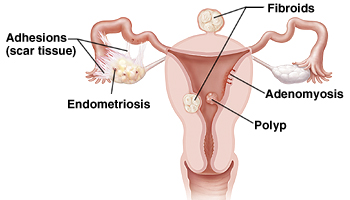Problems Laparoscopic Hysterectomy Can Treat
Problems Laparoscopic Hysterectomy Can Treat
Some health problems can cause pain or bleeding in the uterus. These problems can sometimes be helped by medicine. Or surgery may be done that keeps the uterus intact. But sometimes, the best way to relieve pain and bleeding is to remove the uterus using laparoscopic hysterectomy. It’s done using small incisions.

The following are conditions hysterectomy can treat:
Fibroids. A fibroid is a lump of muscle tissue. It grows in or on the wall of the uterus. It is not cancer. A fibroid can cause pain and heavy bleeding. It may press on the bladder or rectum. This can lead to frequent urination, constipation, and other problems.
Endometriosis. Endometriosis is the growth of the uterine lining outside of the uterus. This tissue can lead to scarring (adhesions). This scarring occurs inside the pelvic cavity. This can cause severe pain.
Gynecological cancer. Ovarian, fallopian tube, uterine and cervical cancers can be treated. Many times additional tissues are removed when cancer is involved.
Endometrial hyperplasia. This is when the endometrium has abnormal cell changes that can precede cancer of the endometrium.
Cervical dysplasia. This is a change in the cervix that precedes certical cancer.
Uterine prolapse. This is when the uterus drops from the normal location
Other Problems
Abnormal bleeding may be due to other causes. These include:
Adenomyosis. This is the growth of the endometrium into the uterine muscle.
Uterine polyps. These are fleshy growths of tissue from the uterine wall.
Updated:
October 03, 2017
Sources:
Laparoscopy FAQ, American College of Obstetricians and Gynecologists, Overview of hysterectomy, Up To Date, Pathogenesis, Clinical Features, and Diagnosis of Endometriosis, Up To Date
Reviewed By:
Goode, Paula, RN, BSN, MSN,Sacks, Daniel, MD, FACOG